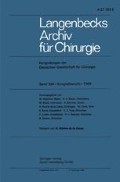Summary
The most severe complications and thus the central problems of septic peritonitis are circulatory failure and general intoxication due to the accompanying paralytic ileus. The prognosis depends on early diagnosis, the point in time of surgical intervention, and chiefly, upon the treatment of the sequalae of peritonitis. This is because of the vasotoxic damage to the circulation and the vital functional areas dependent upon it. From the point of view of pathogenesis and pathophysiology proteases that have been liberated by invasion of endotoxins, by inflammation, and by autolysis, are involved, which are able to liberate plasma kinins, which in turn increase permeability. Following on earlier investigations of Trasylol in experimental and clinical peritonitis due to perforations, kallikrein was determined in mesenteric and peripheral venous blood in cases of experimental and clinical ileus with transmigration peritonitis. Increased kallikrein activities were found especially in mesenteric-portal venous blood, depending upon the duration, the severity, the metabolic disturbances, and the cause of the peritonitis. After operation and treatment with protease inhibitors these kallikrein values fell. In several patients who had intestinal-toxic and septic syndromes that were due to other causes, proteolytic stress was also recognizable. No causal effect should be expected from Trasylol in protracted shock, because by its very nature as a protease inhibitor it acts only as part of a multienzymatic and multifactorial pathophysiological process.
Zusammenfassung
Die schwerste Komplikation and damit das zentrale Problem der septischen Peritonitis sind die Kreislanfinsuffizienz and die Allgemein-Intoxikation durch den paralytischen Bcgleitileus. Neben der Frühdiagnose and dem Zeitpunkt der chirurgischen Intervention hängt die Prognose entscheidend ab von der Behandlung der Peritonitisfolgezustände. Die Hauptursache dafür muß in einer vaso-toxischen Schädigung des Kreislaufs und der von ihm abhängigen lebenswichtigen Funktionskreise gesucht werden. Hierfür kommen pathogenetisch und pathophysiologisch auch durch Endotoxininvasion, Entzündung und Autolyse freiwerdende Proteasen in Frage, die permeabilitätssteigernde Plasmakinine liberieren können. Nach früheren Untersuchungen zur Wirkung des Trasylol bei der experimentellen und klinischen Perforationsperitonitis wurden beim experimentellen und klinischen Ileus mit Durchwanderungsperitonitis Kallikreinbestimmungen im mesenterialen und peripheren Venenblut durchgeführt. Dabei fanden sich erhöhte Kallikreinaktivitäten besonders im mesenterial-portalen Venenblut, abhängig von der zeitlichen Entwicklung, dem Schweregrad, den metabolischen Störungen und der Peritonitisursache. Nach operativer Behandlung und Proteaseinhibitortherapie trat ein Abfall der erhöhten Kallikreinwerte ein. Auch bei einigen Patienten mit intestinaltoxischen und septischen Krankheitsbildern anderer Ursache war ein Proteolysestress erkennbar. Bei protrahierten Schockzuständen darf vom Trasylol keine kausale Wirkung erwartet werden, da es in seiner Natur als Proteaseninhibitor, in einen multienzymatischen und multifaktoriellen pathophysiologischen Prozeß eingeschaltet ist.
Access this chapter
Tax calculation will be finalised at checkout
Purchases are for personal use only
Preview
Unable to display preview. Download preview PDF.
Literatur
Nagel, M., A. Meyer u. J. Schier: Kreislaufwirkung von Trasylol bei Peritonitis. In: Neue Aspekte der Trasylol-Therapie. Stuttgart: Schattauer 1969.
Author information
Authors and Affiliations
Rights and permissions
Copyright information
© 1969 Springer-Verlag Berlin Heidelberg
About this chapter
Cite this chapter
Nagel, M. (1969). Trasylol und Peritonitis. In: Langenbecks Archiv für Chirurgie. Langenbecks Archiv für Chirurgie. Springer, Berlin, Heidelberg. https://doi.org/10.1007/978-3-662-41130-8_43
Download citation
DOI: https://doi.org/10.1007/978-3-662-41130-8_43
Publisher Name: Springer, Berlin, Heidelberg
Print ISBN: 978-3-662-40650-2
Online ISBN: 978-3-662-41130-8
eBook Packages: Springer Book Archive

